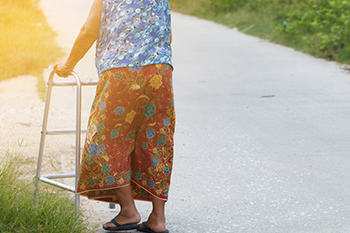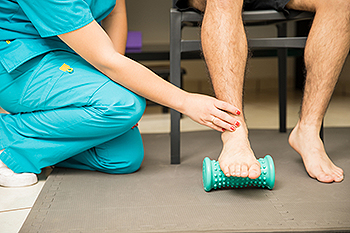Items filtered by date: March 2023
Can Falling Be Prevented?

It is common for the elderly to fall. Research shows falling is the top cause of fractures and major injuries among the elderly population, and they primarily happen at home. Effective fall prevention methods can be implemented to help to reduce falling incidents. Keeping the body strong through regular exercise and stretching routines are beneficial in preventing many falls. Additionally, it is helpful to remove worn rugs, improve lighting in the living environment, and refrain from wearing slippers or walking barefoot. The bathroom may become safer when grab bars are installed in the shower and toilet area. Health can be maintained when regular physical and eye examinations are performed. This can also help to monitor existing medications and update eyeglasses if needed. Falling can impact the feet, and If you would like to learn more about successful fall prevention techniques, please confer with a podiatrist.
Preventing falls among the elderly is very important. If you are older and have fallen or fear that you are prone to falling, consult with Dr. Steven Sheridan from Ankle & Foot Specialty Clinics. Our doctor will assess your condition and provide you with quality advice and care.
Every 11 seconds, an elderly American is being treated in an emergency room for a fall related injury. Falls are the leading cause of head and hip injuries for those 65 and older. Due to decreases in strength, balance, senses, and lack of awareness, elderly persons are very susceptible to falling. Thankfully, there are a number of things older persons can do to prevent falls.
How to Prevent Falls
Some effective methods that older persons can do to prevent falls include:
- Enrolling in strength and balance exercise program to increase balance and strength
- Periodically having your sight and hearing checked
- Discuss any medications you have with a doctor to see if it increases the risk of falling
- Clearing the house of falling hazards and installing devices like grab bars and railings
- Utilizing a walker or cane
- Wearing shoes that provide good support and cushioning
- Talking to family members about falling and increasing awareness
Falling can be a traumatic and embarrassing experience for elderly persons; this can make them less willing to leave the house, and less willing to talk to someone about their fears of falling. Doing such things, however, will increase the likelihood of tripping or losing one’s balance. Knowing the causes of falling and how to prevent them is the best way to mitigate the risk of serious injury.
If you have any questions, please feel free to contact our office located in Sandusky, MI . We offer the newest diagnostic and treatment technologies for all your foot care needs.
Blisters and Shoes Without Socks

Blisters can form on the feet for a variety of different reasons. Blisters, once they develop, can take form as pockets of fluid on the outer layer of the skin. Often, blisters can form on the feet in response to friction or pressure. Commonly, pain and blisters can form when an individual wears summer shoes without any socks. This can be particularly pronounced when wearing leather shoes without socks. To avoid this problem, an individual can take a number of different steps. For example, an individual can wear ankle socks which are not visible from the outside, yet they can effectively protect the feet from the development of blisters on the foot inside of the shoe. If you are someone that likes to wear shoes without any socks, it is highly suggested that you consider contacting a podiatrist to schedule an appointment.
Blisters are prone to making everyday activities extremely uncomfortable. If your feet are hurting, contact Dr. Steven Sheridan of Ankle & Foot Specialty Clinics. Our doctor can provide the care you need to keep you pain-free and on your feet.
Foot Blisters
Foot blisters develop as a result of constantly wearing tight or ill-fitting footwear. This happens due to the constant rubbing from the shoe, which can often lead to pain.
What Are Foot Blisters?
A foot blister is a small fluid-filled pocket that forms on the upper-most layer of the skin. Blisters are filled with clear fluid and can lead to blood drainage or pus if the area becomes infected.
How Do Blisters Form?
Blisters on the feet are often the result of constant friction of skin and material, usually by shoe rubbing. Walking in sandals, boots, or shoes that don’t fit properly for long periods of time can result in a blister. Having consistent foot moisture and humidity can easily lead to blister formation.
Prevention & Treatment
It is important to properly care for the affected area in order to prevent infection and ease the pain. Do not lance the blister and use a Band-Aid to provide pain relief. Also, be sure to keep your feet dry and wear proper fitting shoes. If you see blood or pus in a blister, seek assistance from a podiatrist.
If you have any questions, please feel free to contact our office located in Sandusky, MI . We offer the newest diagnostic and treatment technologies for all your foot care needs.
Where Is Morton’s Neuroma Pain Felt?

Morton’s neuroma is a benign foot condition that causes pain between the third and fourth toes. Wearing tight shoes, such as high heels, may cause the nerve between these two toes to become compressed or irritated, which may cause pain and discomfort. Some patients explain the sensation of Morton’s neuroma as stepping on a marble or small rock stuck inside their shoe. Some also say it feels like pins and needles. Relief may come from wearing custom-made orthotics, in addition to performing stretches to help strengthen the foot. In severe cases, surgery may be necessary to remove the affected nerve for permanent healing. If you have pain in this part of your foot, it is suggested that you schedule an appointment with a podiatrist who can effectively diagnose and treat Morton’s neuroma.
Morton’s neuroma is a very uncomfortable condition to live with. If you think you have Morton’s neuroma, contact Dr. Steven Sheridan of Ankle & Foot Specialty Clinics. Our doctor will attend to all of your foot care needs and answer any of your related questions.
Morton’s Neuroma
Morton's neuroma is a painful foot condition that commonly affects the areas between the second and third or third and fourth toe, although other areas of the foot are also susceptible. Morton’s neuroma is caused by an inflamed nerve in the foot that is being squeezed and aggravated by surrounding bones.
What Increases the Chances of Having Morton’s Neuroma?
- Ill-fitting high heels or shoes that add pressure to the toe or foot
- Jogging, running or any sport that involves constant impact to the foot
- Flat feet, bunions, and any other foot deformities
Morton’s neuroma is a very treatable condition. Orthotics and shoe inserts can often be used to alleviate the pain on the forefront of the feet. In more severe cases, corticosteroids can also be prescribed. In order to figure out the best treatment for your neuroma, it’s recommended to seek the care of a podiatrist who can diagnose your condition and provide different treatment options.
If you have any questions, please feel free to contact our office located in Sandusky, MI . We offer the newest diagnostic and treatment technologies for all your foot care needs.
Plantar Fasciitis and Foot Rollers

Plantar fasciitis is an affliction of the foot that you might already have heard of, even if you are a novice to the field of podiatry. This is because it is one of the most common foot conditions that can cause patients heel pain or pain in the arch of the foot. It is caused by the inflammation of the plantar fascia, which runs along the sole of the foot. There are many different ways that a medical professional like a podiatrist might advise you to go about treating this condition. One technique that a podiatrist might recommend is gently rolling your foot over a foot roller, cold water bottle, or tennis ball. The point of repeatedly rolling the arch of your foot over one of these objects is to stretch and provide relief to the arch of the foot. If you are someone who is living with plantar fasciitis and you are searching for relief, it is suggested that you contact a podiatrist today for more details.
Plantar fasciitis can be very painful and inconvenient. If you are experiencing heel pain or symptoms of plantar fasciitis, contact Dr. Steven Sheridan from Ankle & Foot Specialty Clinics. Our doctor can provide the care you need to keep you pain-free and on your feet.
What Is Plantar Fasciitis?
Plantar fasciitis is the inflammation of the thick band of tissue that runs along the bottom of your foot, known as the plantar fascia, and causes mild to severe heel pain.
What Causes Plantar Fasciitis?
- Excessive running
- Non-supportive shoes
- Overpronation
- Repeated stretching and tearing of the plantar fascia
How Can It Be Treated?
- Conservative measures – anti-inflammatories, ice packs, stretching exercises, physical therapy, orthotic devices
- Shockwave therapy – sound waves are sent to the affected area to facilitate healing and are usually used for chronic cases of plantar fasciitis
- Surgery – usually only used as a last resort when all else fails. The plantar fascia can be surgically detached from the heel
While very treatable, plantar fasciitis is definitely not something that should be ignored. Especially in severe cases, speaking to your doctor right away is highly recommended to avoid complications and severe heel pain. Your podiatrist can work with you to provide the appropriate treatment options tailored to your condition.
If you have any questions please feel free to contact our office located in Sandusky, MI . We offer the newest diagnostic and treatment technologies for all your foot and ankle needs.

